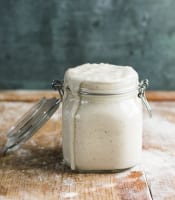Description
Learn how to feed and maintain a successful sourdough starter in 3 easy steps! Tips shared for choosing the best flour, the right jar, and how to keep it alive (without the stress).
Ingredients
- Sourdough Starter
- Jar with lid (I use this one)
- Digital Kitchen Scale
- Bread flour or all purpose
- Water, filtered or regular quality tap water
Instructions
*Note: Before you begin, establish a regular feeding time. Morning or evening; the time itself doesn’t matter. What does matter is consistency. Feeding your starter at roughly the same time each day will train it to rise and fall predictably. This way, you’ll know when it’s ready to use. For example, if you want to make dough at 7 PM (and your starter takes about 5 hrs to rise), feed it at 2 PM.
- Remove and discard half of your sourdough starter from the jar.
- Feed what’s left in the jar with equal parts flour and water by weight (1:1:1 feeding ratio). You need a digital kitchen scale for this. Because we all work with different quantities of starters, this 1:1:1 feeding ratio is best understood by example. So, if you have 60 g of starter in the jar, feed it with 60 g flour + 60 g water. If you have 30 g of starter, feed it with 30 g of flour and 30 g of water. Mix well with a fork, scraping down the sides as needed. Cover the jar with a lid. The lid can be airtight or loosely placed on top- your choice. Note: if the jar is airtight, the pressure will build up fast. Keep an eye on the jar so it doesn’t burst.
- Let your starter rise at room temperature, ideally 75+ F (the warmer it is, the faster it will rise), until bubbly, active and double in size (2-12 hrs). When your starter is at peak height, it’s ready to use. Eventually it will fall back down, and become inactive again. Then, you’ll need to repeat the feeding process.
